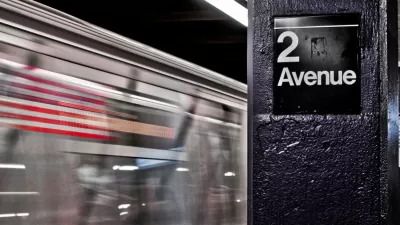As New York City faces its worst financial crisis in 2 decades, a NYC D.O.T. study was released showing that from 2003-2007, the increase in jobs and people was accompanied by a slight decrease in traffic due primarily to increased transit usage.
"The study is the first analysis to take an overall look at traffic and transit patterns in New York during the boom years from 2003 through 2007, when, according to the report, the city added more than 200,000 jobs and its population increased by more than 130,000."
"'What you see is that for the first time since at least World War II, all of the growth in travel in the city has been absorbed by non-auto modes, primarily by mass transit,' said Bruce Schaller, New York's deputy transportation commissioner for planning and sustainability, who wrote the study, which is to be released on Monday (12/15).
The study revealed that "the volume of traffic on the streets and highways remained largely unchanged, in fact declining slightly. Instead, virtually the entire increase in New Yorkers' means of transportation during those robust years occurred in mass transit, with a surge in subway, bus and commuter rail riders."
"'...we've really turned a corner in the city in that all of the growth in travel over the last four years has been absorbed by mass transit and so, in terms of the city's sustainability goals, this is very encouraging to see,' said Schaller."
FULL STORY: New York City Grew, but Traffic Didn’t

Alabama: Trump Terminates Settlements for Black Communities Harmed By Raw Sewage
Trump deemed the landmark civil rights agreement “illegal DEI and environmental justice policy.”

Planetizen Federal Action Tracker
A weekly monitor of how Trump’s orders and actions are impacting planners and planning in America.

The 120 Year Old Tiny Home Villages That Sheltered San Francisco’s Earthquake Refugees
More than a century ago, San Francisco mobilized to house thousands of residents displaced by the 1906 earthquake. Could their strategy offer a model for the present?

In Both Crashes and Crime, Public Transportation is Far Safer than Driving
Contrary to popular assumptions, public transportation has far lower crash and crime rates than automobile travel. For safer communities, improve and encourage transit travel.

Report: Zoning Reforms Should Complement Nashville’s Ambitious Transit Plan
Without reform, restrictive zoning codes will limit the impact of the city’s planned transit expansion and could exclude some of the residents who depend on transit the most.

Judge Orders Release of Frozen IRA, IIJA Funding
The decision is a victory for environmental groups who charged that freezing funds for critical infrastructure and disaster response programs caused “real and irreparable harm” to communities.
Urban Design for Planners 1: Software Tools
This six-course series explores essential urban design concepts using open source software and equips planners with the tools they need to participate fully in the urban design process.
Planning for Universal Design
Learn the tools for implementing Universal Design in planning regulations.
Clanton & Associates, Inc.
Jessamine County Fiscal Court
Institute for Housing and Urban Development Studies (IHS)
City of Grandview
Harvard GSD Executive Education
Toledo-Lucas County Plan Commissions
Salt Lake City
NYU Wagner Graduate School of Public Service



























